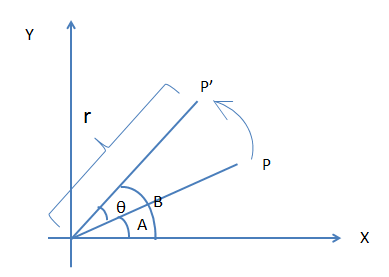这是补充记录关于CG的几何变换的一些知识,涉及到简单的矩阵变换
变换矩阵
在Core Graphics进行图层缩放、旋转、平移的时候,本质的操作就是使用CGAffineTransform这个3x2矩阵对象,与我们的CGPoint这个1x2的矩阵(其实就是对应就是[x,y]这个向量)进行矩阵相乘操作,得到的新矩阵就是变换后的新向量。一般通过CALayer得到的图层都是矢量,因此可以把整个图层进行相应的缩放、旋转、平移。
1 | typedef struct CGAffineTransform { |
这个结构体对应的矩阵如下(看不到LaTeX公式的请看Apple Developer Document):
$ \begin{bmatrix} a & b & 0 \\ c & d & 0 \\ t_{x} & t_{y} & 1 \end{bmatrix} $
Apple采用了用[1]补齐1x3的向量,和用[0,0,1]的转置补齐的3x3的变换矩阵相乘来做仿射变换。虽然可能觉理论上可以直接用2x3变换矩阵和3x1的向量([x,y,1]的转置)运算,得到一个2x1的向量,省3个CGFloat的空间。但是由于这种变换操作叠加次数特别多,与其每次得到的向量结果再补齐[1],还不如一次性就用一个1x3和3x3运算,用空间换取时间,这也许是QuartzCore的实现者的考虑吧。
$ \begin{bmatrix} x & y & 1 \end{bmatrix} \times \begin{bmatrix} a & b & 0 \\ c & d & 0 \\ t_{x} & t_{y} & 1 \end{bmatrix} = \begin{bmatrix} ax+cy+t_{x} & bx+dy+t_{y} & 1 \end{bmatrix} $
注意:iOS上坐标原点从屏幕左上方起,x轴指向右方,y轴指向下方。macOS的原点在屏幕左下方,x轴指向右方,y轴指向上方,要注意区别
平移
变换矩阵第三行的t_x和t_y对应的就是x、y的平移量,因此矩阵变换很简单,比如将[x,y]向量平移到[x+a,y+b]:
平移矩阵:
$ \begin{bmatrix} x & y & 1 \end{bmatrix} \times \begin{bmatrix} 1 & 0 & 0 \\ 0 & 1 & 0 \\ a & b & 1 \end{bmatrix} = \begin{bmatrix} x+a & y+b & 1 \end{bmatrix} $
对应API:
1 | CGAffineTransform CGAffineTransformMakeTranslation(CGFloat tx, CGFloat ty); |
缩放
缩放的本质,就是对向量[x,y]通过同时乘以相同的系数a,得到[ax,ay],那么矩阵很简单,只需要一个对角矩阵,系数都为a就行
缩放矩阵:
$\begin{bmatrix} x & y & 1 \end{bmatrix} \times \begin{bmatrix} a & 0 & 0 \\ 0 & a & 0 \\ 0 & 0 & 1 \end{bmatrix} = \begin{bmatrix} ax & by & 1 \end{bmatrix} $
这个可以使用CA的API来简单构造(也可以直接自己初始化):
1 | CGAffineTransform CGAffineTransformMakeScale(CGFloat sx, CGFloat sy); |
旋转
旋转的变换矩阵初看上去好像难以理解(各种cos、sin),其实就是一个简单的解方程的出来的结果,注意这里需要的是弧度,而且iOS上旋转的正弧度代表顺时针(macOS上就是正弧度是顺时针),需要注意
旋转矩阵:
$ \begin{bmatrix} x & y & 1 \end{bmatrix} \times \begin{bmatrix} \cos \theta & \sin \theta & 0 \\ - \sin \theta & \cos \theta & 0 \\ 0 & 0 & 1 \end{bmatrix} = \begin{bmatrix} x \cos \theta - y \sin \theta & x \sin \theta + y \cos \theta & 1 \end{bmatrix} $
推导过程:

$ P = (x,y) = (r\cos A , r\sin A) \\ P^{‘} = (r \cos B, r \sin B) = (r\cos(A + \theta), r\sin(A + \theta)) \\ r\cos(A + \theta) = r\cos A \cos \theta - r\sin A \sin \theta = x \cos \theta - y \sin \theta \\ r\sin(A + \theta) = r\sin A \cos \theta + r\cos A \sin \theta = y \cos \theta + x \sin \theta \\ \therefore M = \begin{bmatrix} \cos \theta & \sin \theta & 0 \\ - \sin \theta & \cos \theta & 0 \\ 0 & 0 & 1 \end{bmatrix} $
对应API:
1 | CGAffineTransform CGAffineTransformMakeRotation(CGFloat angle); |
弧度可以用自带的定义,比如M_PI_4这些,也可以手动转换,比如用弧度、角度转换的宏:
1 |
错切
错切,就是一种特殊的线性变换(不平移),指的是某一个坐标轴依赖不变,另一个轴线性变换,参考Wiki上的图片:
错切矩阵:
$ \begin{bmatrix} x & y & 1 \end{bmatrix} \times \begin{bmatrix} 1 & 0 & 0 \\ m & 1 & 0 \\ 0 & 0 & 1 \end{bmatrix} = \begin{bmatrix} x+my & y & 1 \end{bmatrix} $
这种变换没有提供专用的API,我们自己可以用CGAffineTransformIdentity创建一个矩阵,然后赋值矩阵中c或者b的值就行
叠加
既然了解了这些图层操作的矩阵变换,我们也可以自己定义矩阵,比如非线性变换(得到的向量不平行)、也可以把几个连续的变换串起来,这时候就要注意矩阵的运算顺序,比如先缩放50%,再旋转M_PI_4,再平移到[x+100,y],那么等价于沿着45度平移50的距离(对应结果坐标就成了[x*sqrt(2)/4, y*sqrt(2)/4])
对应API:
1 | CGAffineTransform CGAffineTransformConcat(CGAffineTransform t1, CGAffineTransform t2); // 最通用 |